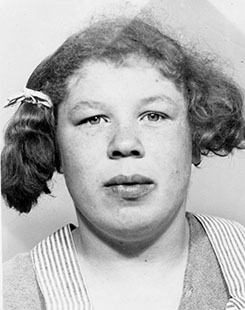Search for Names, Places and Biographies
Already layed Stumbling Stones
Suche
Emma Ertel * 1919
Horner Landstraße 407 (Hamburg-Mitte, Horn)
HIER WOHNTE
EMMA ERTEL
JG. 1919
EINGEWIESEN 14.8.1943
’HEILANSTALT’
AM STEINHOF / WIEN
ERMORDET 4.12.1944
Emma Ertel, born 8 June 1919 in Hamburg, died 4 Dec. 1944 in the Wagner von Jauregg Mental Institute, Vienna (Wagner von Jauregg-Heil- und Pflegeanstalt der Stadt Wien)
Horner Landstraße 407
Although Emma Ertel was described in the 1930s as "the burden of the ward,” Dr. S. wrote to the Social Office of the Hamburg State Welfare Agency on 22 September 1942: "The patient suffers from epilepsy. She can wash herself, does small jobs, efficiently if somewhat slowly. Her behavior is social. Her overall physical condition is good.” There was nothing to indicate that Emma Ertel was a patient who needed more care than others, and whose transfer to another institution would have relieved the workload of the staff. The reasons for her transfer to the Wagner von Jauregg Mental Hospital in Vienna cannot be determined from her hospital records.
Emma was born on 8 June 1919. She was the second daughter of Wilhelm Ertel, an employee of the public transport authority, and his wife Anna, née Heitmann. They lived at Döhnerstraße 17 in Hamm-Mitte. Emma was christened on 6 July 1919 at the Dankeskirche. When her parents divorced, Wilhelm and the two daughters moved to Horner Landstraße 407 in Horn. Anna remained in the apartment on Döhnerstraße. Wilhelm remarried in 1926 and had two more children.
Emma started to walk and talk at age three. When she was still unable to do the required schoolwork at age nine, she was sent to a school for children with learning disabilities in the spring of 1928. She left the school a short time later, however, because she was unable to get along with the other children.
Shortly before her tenth birthday she was sent to the Friedrichsberg State Hospital. The Hamburg Youth Welfare Office ordered that she be examined and put under observation with their psychiatric service in the Overbeck Home on Averhoffstraße, after which she was sent to the Alsterdorf Institution. Once she had settled in, she proved to be calm and playful, and further schooling was postponed. She spent several holidays at home. In 1931 she began to have spells of intense agitation, during which she destroyed objects around her. As a result she was moved to the observation ward (see note, p. 25), where she always behaved well. She seldom if ever had epileptic seizures. There was no definitive diagnosis.
The next years were eventful. Emma crushed her left knee, and while it was healing an infected nail had to be removed. In 1932 she developed tuberculosis in her knee joint. Despite diverse treatments, it worsened, and her left leg had to be amputated at the thigh in 1934. Afterwards she contracted pneumonia, and was then moved to the infectious diseases ward on suspicion of dysentery. In October she was given a prosthesis, but she didn’t use it and learned to move nimbly and quickly on one leg. She continued to aggravate her fellow patients, which led to frequent arguments. In the following two years Emma was quiet, friendly and cooperative. She helped children to dress and undress, sought other activities and entertained herself for long periods of time. Then her behavior reverted to harassment of other patients. She again suffered from infectious illnesses. In 1941 Emma’s behavior was able to be brought under control with a combination of medications.
Emma was transferred to the Wagner von Jauregg Mental Institute in Vienna, with an unclear diagnosis and at a weight of 49 kg (108 lbs). She said the reason for her transfer was that "everything in Hamburg is kaput.” By the summer of 1944 she weighed 57 kg (126 lbs), was in need of special care, but remained "low maintenance”: accessible, friendly, pleasant and clean. She died on 4 December 1944 of an untreated case of pneumonia, and was buried at the Central Cemetery in Vienna.
Her father had survived Operation Gomorrah, the allied bombing raid over Hamburg, and received the news of her death at his new address, Horner Weg 234.
Translator: Amy Lee
Kindly supported by the Hermann Reemtsma Stiftung, Hamburg.
© Stolperstein-Initiative Hamburg-Horn
Quellen: Ev. Stiftung Alsterdorf, Archiv, V 354; Jenner, Meldebögen, in: Wunder/Genkel/Jenner, Ebene, S. 169–178; Wunder, Abtransporte, S. 181–188; ders., Exodus, ebd. S. 189–236.


